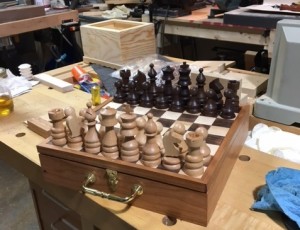Today’s post is written by Stephen Parsons.
My most recent commission is for a portable chess set for the son of a colleague. I have been hoping for a chance to design and create chess sets for awhile and this contract presents the opportunity to explore what may become a staple in the ChezCraft woodworking product suite.
Although the elements of chess sets are pretty fundamental, there are several unique aspects that make it a challenging and creatively stimulating project. I have been cautioned by members of AWA (our local woodworking association) that attention to the accuracy of cuts and joins is critical because any flaw in the sizing of the tiles in the board will be very obvious. Accordingly, having your equipment set up to deliver consistent and accurate result is a vital requirement.
 While a chess set seems a pretty standard offering, there are lots of opportunities to exercise creativity and diversity in design. Overall size, selection of materials, and joinery of the board and case offer plenty of chances to customize. The design of the playing pieces offer even more opportunities for creative expression. The board and pieces shown are the prototype for our mid-size chess set (case is about 10.5″ x 10.5″ x 3″) and use a standard set of chess playing pieces. While the case (cherry) and board (maple & walnut) required good woodworking skills, making the walnut and maple playing pieces required skill and care at the lathe and a great deal more shop time than I thought they would.
While a chess set seems a pretty standard offering, there are lots of opportunities to exercise creativity and diversity in design. Overall size, selection of materials, and joinery of the board and case offer plenty of chances to customize. The design of the playing pieces offer even more opportunities for creative expression. The board and pieces shown are the prototype for our mid-size chess set (case is about 10.5″ x 10.5″ x 3″) and use a standard set of chess playing pieces. While the case (cherry) and board (maple & walnut) required good woodworking skills, making the walnut and maple playing pieces required skill and care at the lathe and a great deal more shop time than I thought they would.
Lessons Learned:
It was nice to be able to have a commission to develop this prototype and I know the client was happy to be able to see and handle the model in advance of final design. The next version (and likely the full product line) will take lessons learned as well as the feedback from the client into that final build. In developing box cases, my strength and signature style is in box-joint joinery rather than mitered boxes like the one shown here. So for the rest of the line I will use my box joint jig to build cases that are more in keeping with that strength while offering a unique and attractive joinery style.
 I learned a couple of important lessons about board construction including simplifying the way the tiles are created through a two-step (alternating pattern) strip-cut method, and cutting the base board (1/4″ baltic birch) on the table saw so that there is no visible tear-out. I have also acquired a lathe duplicator that will allow me to create the pieces quickly and consistently using my own custom designed templates. Finally, I will be offering a set of uniquely designed playing pieces that are less traditional – more abstract – as shown in the attached illustration. We’ll post images and comments of the final product on our Facebook Page early in the New Year.
I learned a couple of important lessons about board construction including simplifying the way the tiles are created through a two-step (alternating pattern) strip-cut method, and cutting the base board (1/4″ baltic birch) on the table saw so that there is no visible tear-out. I have also acquired a lathe duplicator that will allow me to create the pieces quickly and consistently using my own custom designed templates. Finally, I will be offering a set of uniquely designed playing pieces that are less traditional – more abstract – as shown in the attached illustration. We’ll post images and comments of the final product on our Facebook Page early in the New Year.

Recent Comments